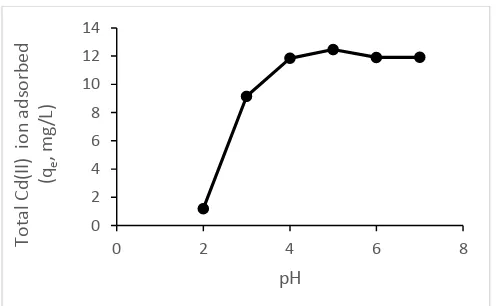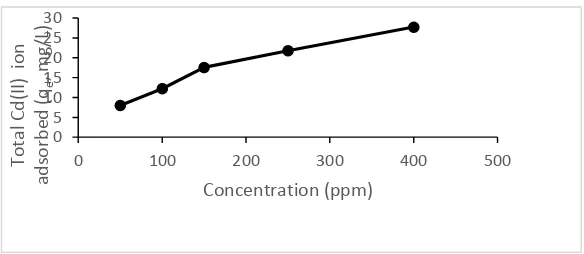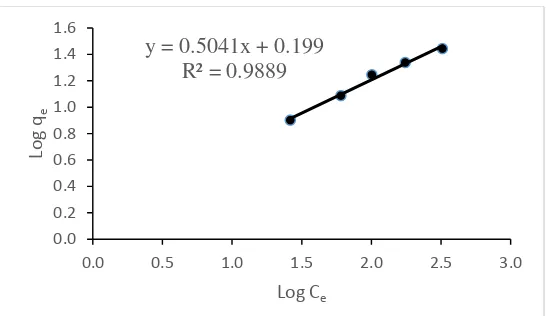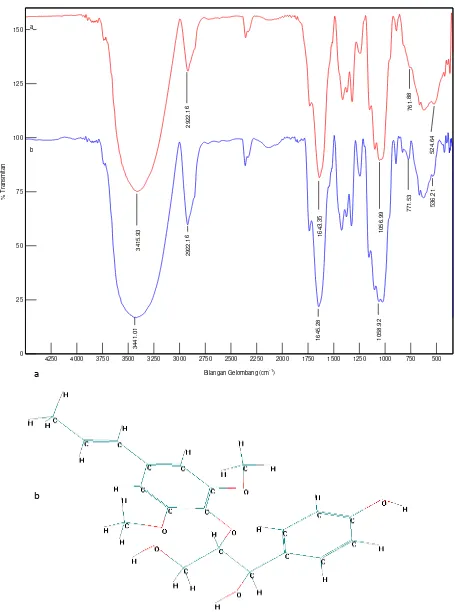18
BIOSORPTION OF Cd(II) ION BY DRAGON FRUIT PEEL (Hylocereus polyrhizus)
A. M. Tanasal, N. La Nafie, P. Taba1
Department of Chemistry, Faculty of Mathematics and Natural Sciences, Hasanuddin University, Makassar, South Sulawesi 90425
Abstrak. Kulit buah naga merupakan material yang melimpah dan murah. Material ini telah digunakan sebagai adsorben dalam proses biosorpsi untuk penghilangan ion logam Cd(II) dari limbah cair. Biosorpsi ion logam Cd(II) oleh kulit buah naga dilakukan pada variasi waktu kontak, pH dan konsentrasi. Konsentrasi ion logam Cd(II) sebelum dan setelah adsorpsi ditentukan dengan menggunakan Spektrofotometer Serapan Atom (SSA). Hasil penelitian menunjukkan bahwa waktu optimum yang diperoleh adalah 20 menit dan pH optimum adalah 5. Kapasitas adsorpsi ion Cd(II) oleh kulit buah naga ditentukan dengan menggunakan isotermal adsorpsi Langmuir dan Freundlich. Dari hasil penelitian ini diperoleh bahwa biosorpsi ion logam Cd(II) dengan menggunakan kulit buah naga sesuai dengan model isotermal Langmuir dengan nilai kapasitas biosorpsi (Qo) yakni sebesar 36,50 mg/g. Gugus fungsi yang terlibat dalam biosorpsi ion logam Cd(II) oleh kulit buah naga adalah gugus hidroksil (-OH).
Kata kunci: biosorpsi, Cd(II), isotermal adsorpsi, kulit buah naga, SSA.
Abstract. Dragon fruit peel is a material that is abundant and cheap. The material has been used as an adsorbent in the biosorption process for the removal of metal ions of Cd(II) from wastewater. Biosorption of Cd(II) ion by dragon fruit peel was done on the variation of contact time, pH and concentration. The concentration of metal ions Cd(II) before and after adsorption was determined using Atomic Absorption Spectrophotometer (AAS). Results showed that the optimum time was 20 minutes and the optimum pH was 5. Adsorption capacity was studied by both isotherm adsorptions of Langmuir and Freundlich. Results showed that the biosorption of Cd(II) ion using dragon fruit peel full filled the isotherm Langmuir model with the biosorption capacity (Qo) of 36,50 mg/g. The functional group involved in metal ion biosorption of Cd(II) by the peel of dragon fruit is a hydroxyl group (-OH).
Keywords: biosorption, Cd(II), adsorption isotherm, dragonfruitpeel, AAS.
19
INTRODUCTION
Environmental pollution is now increasing rapidly, mainly due to industrial activities. This is caused by industrial waste containing heavy metals from a variety of chemicals that are very harmful and toxic for living beings even in low concentrations (Achmad, 2004).
Cadmium (Cd) is one of the heavy metals that contaminate aquatic environments as a result of the disposal of industrial waste and mining waste. Cadmium is widely used in metal plating process is a heavy metal that is dangerous because it can cause high blood pressure, kidney damage, testicular tissue damage and destruction of red blood cells happening around Toyama city Jinzu river island Honsyu Japan in 1960. Patients experiencing softening entire body skeleton followed by death due to kidney failure. The disease is known as Itai-itai Disease (Wardhana, 2001).
Efforts to combat
environmental pollution previously have been carried out. Deposition method, oxidation-reduction, ion exchange, filtration, evaporation, reverse osmosis, and solvent extraction is a common method used to remove represents a challenge and biosorption can be a solution of this problem (Viera dan Volesky, 2000).
Biosorption is one of alternative techniques for waste treatment, that is taking metals by biological materials or biosorbent from the solution. This method is competitive, cheap and effective (Volesky, 2001). Biosorbent available abundance both naturally and as a product or waste industrial activity, has a high adsorption capacity, and allow it to be renewed(Bailey et al., 1999).
Some product of industrial and agricultural activities result has the potential to be used as an inexpensive adsorbent. Green coconut shell powder
(Cocos nucifera) potentially removing
Cd (II)ions (Widihati et al., 2010). ions. La Nafie et al. (2012) utilizes red meranti wood powder as biosorbent cadmium ions. Previous research has also been done using dragon fruit peel as biosorbent metal ions Mn(II) (Priyantha et al., 2013), Pb(II) dan Ni(II) (Mallampati, 2013).
20 cellulose, carbohydrates, proteins and other phenolic compounds in which there are nitrogen, carbon, hydrogen, and sulfur. All of these contain a hydroxyl and carboxyl that can binding pollutants in this case is a metal ion (Mallampati, 2013).
Based on the above argument it is necessary to investigate the ability of dragon fruit peel powder
(Hylocereus polyrhizus) are known to
contain cellulose, pectin and lignin in adsorbing heavy metals, especially the heavy metal cadmium (Cd) and the optimum condition adsorption cadmium (Cd) ions metal.
MATERIALS AND METHODS filter paper, alumunium foil, universal pH paper, and label paper.
Instrumentationresearch
Tools used in this study are tools glass commonly used, oven SPNISOSFD models, magnetic stirrer velp scientific a models, digital scale Ohaus NO AP210 models, sieve (100 mesh dan 230 mesh), cusher, atomic absorption spectrophotometer (AAS) buck scientific 205 VGP models, desiccator, centrifuge angular 6 select a models, ultrasonic and FT-IR spectrophotometer SHIMADZU 8201 PC models, pH meter WTW 315i models.
Procedure
Preparation biosorbent dragon fruit peel(Hylocereus polyrhizus)
Dragon fruit peel is washed with running water to remove dirt, rinsed with aquabidestand drained. Dragon fruit peel then cut into small pieces and dried in the sun for 7 days. After that dragon fruit peel is heated at 80 ° C for 24 hours and stored in a desiccator. Afterwards, dragon fruit peel crushed using the crusher, and sieved with a 100 mesh size sieve but did not pass 230 mesh sieve. Dragon fruit peel powder then heated at 80 ° C and stored in a desiccator.
Production the Cd(II) solution
Cd(NO3)2.4H2O powder weighed as
much as 2,7424 gram, then dissolved withHNO3 p.a and diluted with
aquabidest until the volume of solution of 1 L. Subsequently standard solution of Cd(II) with a concentration of 1000 mg/L pipette 100 mL and diluted to a volume of solution 1 L to create a standard solution of Cd(II) 100 mg/L.
Determination of optimum time biosorption Cd(II) ion bydragon fruit peel powder(Hylocereus polyrhizus)
21 experiments performed as above but without shaking with a magnetic
stirrer.
Determination of optimum pH biosorption of Cd(II) ion by dragon fruit peel powder (Hylocereus polyrhizus)
Many as 200 mg of powdered dragon fruit peel put in 50 mL solution of Cd(II) with a concentration of 100 mg/L and pH 2. The mixture was then shaken for optimum time 20 minutes, centrifuged and filtered with Whatman 42 filter paper. The absorbance of the filtrate is measured by AAS. The above experiment was repeated with variations in pH 3, 4, 5, 6 and 7. Each experiment was performed two repetitions. Blank experiments performed as above but without shaking with a magnetic stirrer. The optimum pH is pH where the concentration of adsorbed (Cadsorption)
the largest.
Determination capacity biosorption of Cd(II) ion by dragon fruit peel and 400 mg/L. The mixture shaken for optimum time 20 minute at optimum pH 5, centrifuged and filtered with Whatman 42 filter paper. The absorbance of each filtrate was measured by SSA. Each experiment was performed two repetitions. Blank experiments performed as above but without shaking with a magnetic stirrer.
FT-IR analysis
FT-IR (Fourier Transform Infra Red) spectrum analysis carried out for dragon fruit peel before and after adsorption at FT-IR spectrophotometer SHIMADZU 8201 PC models. Spectra were recorded, the wave number region 4000-340 cm-1with a resolution of 1 cm-1at room temperature with a detector DTGS (Deuterated Triglycine Sulphate). Samples crushed along KBr with a mass ratio of KBr and sample is 1:10. The mixture was then put in a special place that is round and then pressed for 10 minutes at a pressure of 72 Torr (8 to 20 tons per unit area) to produce a very thin circle. Observations on IR spectra is performed to determine changes in the functional groups that occur before and after the process adsorption of Cd(II) by biomass dragon fruit peel.
RESULTS AND DISCUSSION
Optimum time biosorption Cd(II) ion by dragon fruit peel powder (Hylocereus polyrhizus)
Data amount of metal ions Cd(II) adsorbed by dragon fruit peel at different contact time is shown in Figure 1.
Figure 1 shows that the adsorption of Cd(II) by dragon fruit peel increases with shaking time. But to a certain extent the addition shaking time does not affect significantly the amount of ions Cd(II) which is absorbed by dragon fruit peel powder.
22 minute. However, after the 20th minute amount of ion Cd(II) adsorbed decreased relatively small. The relatively small amount of decrease
indicates that the active site on the surface of the dragon fruit peel adsorbent has been saturated with ions Cd(II).
Figure 1. Relationship between contact time (minutes) with the amount of Cd(II) ion adsorbed (mg/g) by the dragon fruit peel powder (pH 5, the initial
concentration of Cd(II) ion = 100 ppm).
According Saikaew and Kaewsarn (2010) removal of metal ions Cd(II) from wastewater by using durian peel powder need adsorption time during 15 minutes. Nailufar (2010) reported that the optimum contact time for the adsorption of Cd(II) by using the tofu pulp is 20 minutes. It is also reported by Pabiban (2009) in which the optimum contact
of adsorption of Cd(II) by dragon fruit peel.
OptimumpHbiosorptionof Cd(II) ionbydragon fruit peel powder(Hylocereus polyrhizus)
One of the most important factors in adsorption besides time is pH. The optimum pH biosorption of Cd(II) ion by dragon fruit peel is determined by counting the amount of Cd(II) ions adsorbed (qe) as a function
of pH. To determine the optimum pH in this study used a pH of 2-7.
23
Figure 2. Relationship between the pH of the amount of Cd(II) ion adsorbed (mg/g) by dragon fruit peel powder (optimum time is 20 minutes, concentration of Cd(II) ion = 100 ppm).
The higher the pH the higher the amount of Cd(II) ions which is absorbed by dragon fruit peel powder. But after passing an optimum pH, the amount of ions Cd(II) which isabsorbed by dragon fruit peel powder began to decline. the adsorbent (Ahmad, et al., 2009). At pH 3-5 an increase in the amount of adsorbed decreased. Decrease the amount of metal ions adsorbed on the adsorption process at high pH occurred before reaching a pH where the metal ions precipitate caused by the formation of hydroxyl complexes of metal ions dissolved so that the metal ion can not bind to the active groups on the adsorbent(Ahmad, et al., 2009). Cd(II) ion precipitated at pH 8.5 to 9 (Hawari dan Mulligan, 2006).
Based on Figure 2, the pH Meranti Wood powder(Shorea
Pamifotia Dyer) (La Nafie, et al.,
2012), and the sagopulp (Pabiban, 2009) as an adsorbent for the adsorption of Cd(II) ion.
The addition of acid on biosorption process allows the hydrolysis of cellulose and lignin that can break down the molecules that make available many -OH groups which can bind to Cd(II) ion. This is what might cause the optimum biosorption process occurs at a slightly acidic pH ie at pH 5.
Biosorption capacity of Cd(II) ion by dragon fruit peel powder(Hylocereus polyrhizus).
24 dragon fruit peel powder as a function of ion concentration of Cd(II) ion in Figure 3.
The bigger concentration of Cd(II) ion in solution, the more bigger the amount of Cd(II) ion can be absorbed by dragon fruit peel powder. Figure 3 shows that the adsorbent saturation has not been achieved, so the two models adsorption isotherm (isothermal Langmuir and Freundlich)
is used. Graph showing the relationship between concentration of Cd(II) ion after adsorption (Ce) vs
adsorption capacity (Ce/qe) was
prepared according to the Langmuir adsorption models as shown in Figure 4 and the concentration of Cd(II) ion after adsorption(log Ce) vs adsorption
capacity (log qe) was prepared
according to Freundlich adsorption models as shown in Figure 5.
Figure 3. The relationship between concentration of Cd(II) ion (mg/L) by the amount of Cd(II) ion adsorbed (mg/g) by the dragon fruit peel powder at the optimum time 20 minutes and at optimum pH 5.
25
Figure 5. Curve Freundlich isotherm for adsorption of Cd(II) ion by dragon fruit peel powder
Figures 4 and 5 show that the adsorption is more in line with the adsorption of Cd(II) by dragon fruit peel powder is Langmuir isotherm compared with the Freundlich isotherm models. This can be seen from the Langmuir isotherm equation R2value is0,9913while the Freundlich
isotherm equation is 0,9889. Based on
the Langmuir isotherm
valueQo(adsorption capacity) was
obtained by36,50 mg/g or 0,32 tofu pulp, the adsorption capacity Qois
equal to 17,06 mg/g and Pabiban (2009) eported the adsorption of Cd(II) using the sago pulp value Qo= 11,79
adsorbing Cd(II) ion compared to pulp, pulp sago, and durian peel.
FT-IR analysis results
Biosorbent dragon fruit peel was analyzed by FT-IR to determine the binding functional group Cd(II) ion. FT-IR analysis is done by looking at the change of the IR spectra before and after biosorption of Cd(II) ion by dragon fruit peel shown in Figure 6.
Figure 6a shows a peak at wavenumber 1056,99 cm-1 (stretching C-O), 1643,35 cm-1 (stretching C=O),
2922,16 cm-1 (aliphaticC-H
stretching), dan 3415,93 cm-1
(stretching–OH). The same peaks are also seen in the figure 6b, except peak at 3415,93 cm-1 (stretching –OH)
shifted into 3441,01 cm-1. This shift shows the interaction between the Cd(II) ion with the hydroxyl functional groups (–OH) contained in the skin of dragon fruit. This is reinforced by the
shift in wave numbers 761,88 cm-1and 524,64 cm-1respectively into771,53
26 groups are functional groups involved in biosorption of Cd(II) ion by dragon fruit peel powder. To form complexes, empty orbital on 5s2experience
hybridization provides 4 orbital is 5s and 5p, which is then filled by four pairs of electrons originating from the hydroxyl group(–OH) as a ligand. The bond that is formed is a covalent coordination bond because of the FTIR spectrum peaks (–OH) is not lost but only shifted, so that it can be concluded that the bond formed between groups(–OH)and Cd(II) ion is a covalent coordination bond. Then shift wave numbers become bigger, showing stronger bonding happens.
27
Bilangan Gelombang (cm-1)
%
Figure 7. Hydroxyl Group (–OH) is stunted by steric effects
Figure 6. Spectrum of FT-IR results analysis of dragon fruit peel biosorbent (a) before b
28
Figure 8. Hydroxyl group (–OH) is not stunted by steric effects
O O
H
H
O
CH2
H OH H
OH H O
H OH
CH2OH
H H
H
OH
OH HO
OH O
OCH3
H3CO
O H
H
O
CH2OH
H OH H
OH H O
H OH
CH2
H H
H
OHH
O OH
OH OH
O
OCH3
OCH3
Cd2+
H OH
OH
OH
HO
Figure 9. Forms of bonding that occurred between Cd(II) ion with cellulose and lignin
Figures 7 and 8 show the difference in bond energies on the
hydroxyl group (–OH)1is stunted by
steric effect and (–OH)2is not stunted
totalenergy=74.029 kcal/mol
1
2
2
29 steric effects in the structure of lignin. The bond energy difference indicates that the group tends to bind Cd(II) ion is a group (–OH)2is not stunted by steric
effects. Group (–OH)2is smaller binding
energy tends to be more stable and its structure group (–OH)2more freer than
the group (–OH)1which stunted by
steric effects. The proposed bond forms given in Figure 9.
CONCLUSIONS
Contact time and pH optimum biosorption of Cd(II) ion by dragon fruit peel powder is 20 minutes and pH 5. Biosorption of dragon fruit skin towards Cd(II) ion is in accordance with the Langmuir isotherm with Qo(adsorption
capacity) of 36,50 mg/g or 0,32 mmol/g. Functional group involved in ion biosorption of Cd (II) by dragon fruit peel is a hydroxyl group (-OH).
REFERENCES
1. Achmad, R., 2004, Kimia
Lingkungan, ANDI Yogyakarta,
Yogyakarta. Review of Potentially Low-Cost Sorbents for Heavy Metals, Water Res., 33(11), 2469-2479.
4. Fatoni, A., Hindryawati, N., and Sari, N., 2010, Pengaruh pH Terhadap Adsorpsi Ion Logam Kadmium(II) oleh Adsorben Jerami Padi, J. Kimia Mulawarman, 7(5), 59-61.
5. Hawari, A.H., and Mulligan, C.N., 2006, Biosorption of Lead(II), Cadmium(II), Copper(II), and Nickel(II) by Anaerobic Granular
Biomass, Bioresour. Technol.,97, 692-700.
6. Jethva, H.O., 2015, FTIR Spectroscopic and XRD Analysis of
Gel-Grown, Cadmium
Levo-Tartrate Crystals, IJAR, 1(4), 1-3.
Potential Applications, A Thesis
unpublished
,
Department Of Chemistry National University Of Singapore, Singapore.9. Nailufar, A.A., 2010, Biosorpsi Ion
Cd(II) oleh Ampas Tahu, Skripsi
tidak diterbitkan, Jurusan Kimia, Fakultas Matematika dan Ilmu Pengetahuan Alam, Universitas Hasanuddin.
10.Pabiban, D., 2009, Biosorpsi Ion
Cd(II) oleh Ampas Sagu, Skripsi
tidak diterbitkan, Jurusan Kimia, Fakultas Matematika dan Ilmu Pengetahuan Alam, Universitas Hasanuddin.
11.Priyantha, N., Lim, L.B.L., Dahri, M.K.,and Tennakoon, D.T.B., 2013, Dragon Fruit Skin As a Potential Low-Cost Biosorbent For The Removal of Manganese(II) Ions,
JASES, 8(3), 179-188.
12.Saikaew, M., and Kaewsarn, P., 2010, Durian Peels As Biosorbent For Removal Of Cadmium Ions From Aqueous Solution, J. Environ. Res., 32(1), 17-30.
13.Umar, M. R., and Liong, S., 2014, Efektifitas Serbuk Biji Kelor
Moringa Oleifera Lamk.Dalam
Menurunkan Kadar Kadmium (Cd) Pada Air, J. Alam dan Lingkungan,
30 14.Viera, R.H.S.F., and Volesky, B.,
2000, Biosorption; a solution to pollution, Int. Microbiol, 3, 17-24.
15.Volesky, B., 2001, Detoxificiation
of metal-bearing effluents. Biosorption for the next centry,
Hydrometallurgy, 59(2), 203–216.
16.Widihati, I.A.G., Ratnayani, O., and Angelina, Y., 2010, Karakterisasi Keasaman dan Luas Permukaan Tempurung Kelapa Hijau (Cocos
Nucifera) dan Pemanfaatannya
Sebagai Biosorben Ion Cd2+, J.
Kimia, 4(1), 7-14.
17.Umar, M. R., and Liong, S., 2014, Efektifitas Serbuk Biji Kelor
Moringa Oleifera Lamk.Dalam
Menurunkan Kadar Kadmium (Cd) Pada Air, J. Alam dan Lingkungan,
5(8), 37-42.
18.Viera, R.H.S.F., and Volesky, B., 2000, Biosorption; a solution to pollution, Int. Microbiol, 3, 17-24.
19.Volesky, B., 2001, Detoxificiation
of metal-bearing effluents. Biosorption for the next centry,
Hydrometallurgy, 59(2), 203–216.
20.Widihati, I.A.G., Ratnayani, O., and Angelina, Y., 2010, Karakterisasi Keasaman dan Luas Permukaan Tempurung Kelapa Hijau (Cocos
Nucifera) dan Pemanfaatannya
Sebagai Biosorben Ion Cd2+, J.





